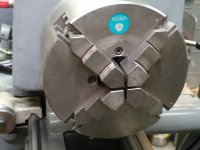Hello
I am new here but I'll get straight into it :-)
Someone pursuaded me to make some bobbins for an antique sewing machine. These have an offset hole in the one side of the spool where a springloaded pin goes into when the bobbin is wound on the winder.
I am now stumped as to how I can repeatedly drill this hole accurately. The OD of the spool is only 9.5mm / 3/8" and the holes sice needed is 1.8mm / 70mils.
I want to drill that hole after machining and parting off the bobbin so that the remaining round stock can remain in the lathe for the next one.
My guess is that I need to make some sort of jig (of course!) but I am just not sure how it should work / look.
The bobbins are about 1 1/4" long with the ends being about 45mil thick discs.
Any suggestions will be greatly appreciated.
I am new here but I'll get straight into it :-)
Someone pursuaded me to make some bobbins for an antique sewing machine. These have an offset hole in the one side of the spool where a springloaded pin goes into when the bobbin is wound on the winder.
I am now stumped as to how I can repeatedly drill this hole accurately. The OD of the spool is only 9.5mm / 3/8" and the holes sice needed is 1.8mm / 70mils.
I want to drill that hole after machining and parting off the bobbin so that the remaining round stock can remain in the lathe for the next one.
My guess is that I need to make some sort of jig (of course!) but I am just not sure how it should work / look.
The bobbins are about 1 1/4" long with the ends being about 45mil thick discs.
Any suggestions will be greatly appreciated.







